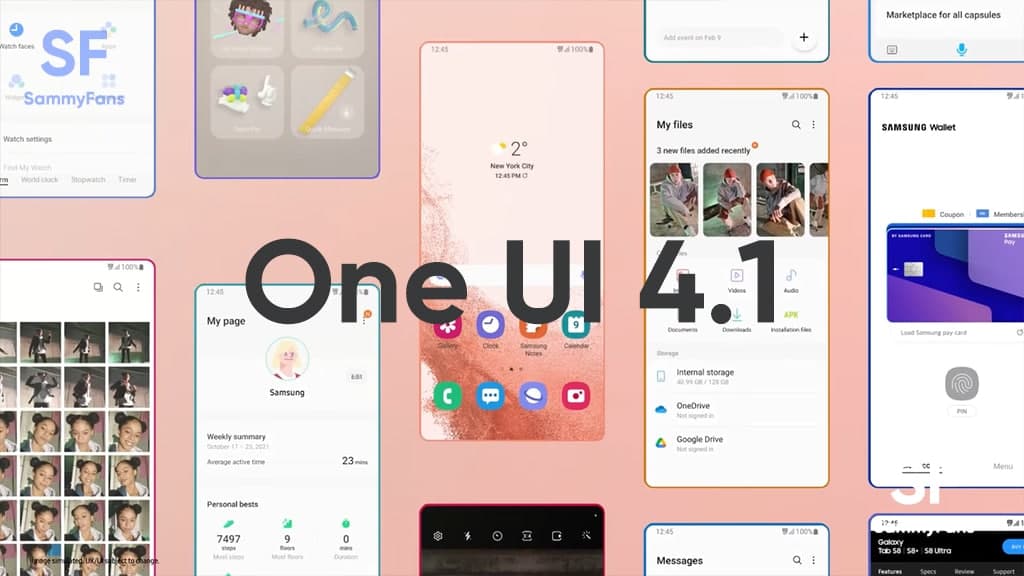With the launch of the Galaxy S22 series Samsung introduced the all-new One UI 4.1 custom skin that offers a wide range of interesting and new features over its previous version. Most of One UI 4.1 features are easy to use and they provide Galaxy users with great customization features.
Stay tuned via SFCNation Telegram
However, in this article, we will discuss some One UI 4.1-based features, as well as a user guide so that you can understand better.

1. Always display brightness slider in quick settings
On your home screen, swipe down to open your notifications, and then swipe down again to expand the Quick Panel. In the upper-right corner, tap the three-dot menu, and then click Quick Panel Layout. This allows you to toggle the brightness slider only when the notification shade is open and full quick settings appear. From here, you can also choose to turn off the media and device control interface, which you will probably never use.
2. Change the keyboard to Gboard
Samsung keyboards have their place, mainly in foldables with Gboard stinks. On a traditional way smartphone, the Google keyboard looks great, especially if you use layouts from other devices. Download Gboard, open the app, and follow the instructions to set it as your default keyboard. If you hate it, you can always uninstall it.
3. Order App Drawer Alphabetical
Samsung’s app drawer, by default, exists handled the way you want it to: new apps appear at the end and you can freely rearrange the apps as you like. If you want to make sense without manually curing your app drawer, open it and tap on the three dots in the top right corner, then Sort -> Alphabetical order.
4. Disable the Bixby key and switch to the Power menu
The power button on newer Samsung phones does not open the Power menu by default. Instead, it’s called Bixby. On your home screen, swipe down to open your notification panel, then click again to expand it. Tap the Power icon in the upper right corner, and then the “Side Key Settings” at the bottom of the screen.
From here, you can change the “side key” back to the power button. We have a complete guide on how to completely disable Bixby which explains in more detail.
5. Enable “Detailed” notifications
One of the things that annoy me the most about a One UI is the small-scale notification banners that are turned on by default; For instance, to use Quick Replies in messages, you must press the small down arrow to expand them. To get full-featured notifications, go to Settings, and then Notifications, and then click “Detailed” at the top. Much improved.
6. Show notification details on the lock screen
Similarly, Samsung hides notification content on your lock screen by default; you need to turn on your screens, and then tap the notification icon to expand them. If you want your lock screen notifications to be expanded by default, go to Settings, then Lock screen, and then Notifications, and then click “Details”.

7. Disable the Edge Panel
Samsung’s Edge Panels allow you to hide app and function shortcuts in a small drawer on your screen. If you’ve annoyed with them in the same way, look for the “Edge Panel” in your phone settings and turn them off.
8. Enable Gesture Navigation
Even with its latest, coolest phones, Samsung is still pushing the old-fashioned three-button navigation. If that is your preference, there is no judgment – but these days gesture navigation is an industry-standard and it takes less time on your phone display. Switch to two gestures, search for “Navigation Bar” in your device settings, and then swipe gestures.
9. Customize your colors with One UI 4.1 Material You
Samsung’s One UI 4.1-based Material You-style dynamic theming creates multiple color palettes for each wallpaper you choose. If your UI seems a bit out of place with the palette you initially selected, but you really like your wallpaper, you can choose a more dynamic palette or complete the theme without choosing a new theme. Can be closed as well.
Long press the blank space on your home screen, then click Wallpaper & Style in the lower-left corner and then click the Color Palette. Here, you can choose a new theme based on your wallpaper or the original black, white and blue theme.
10. Change the default browser to Chrome
Samsung Internet is a great browser, but if you’re a Chrome user anywhere, your history, bookmarks, and payment methods are all waiting to be used in one place. To set Chrome as the default browser on your Samsung phone, long-click on the app icon, click on the I in the corner and then go to the Browser app below the default. Tap to make Chrome your default.
11. Disable putting unused apps to sleep
Over time, installing dozens and dozens of apps can affect your phone’s performance and battery life, as they all work in the background, even if you do not use them. Also, Samsung’s “deep sleep” feature makes sense to less intelligent users: it controls the background activity for apps you haven’t used in a while, avoiding some of the side effects of the brutal app drawer.
Go to Settings >> Battery & Device Protection >> Battery, and then click Background usage limits. Turn off the toggle.


Leave a Reply